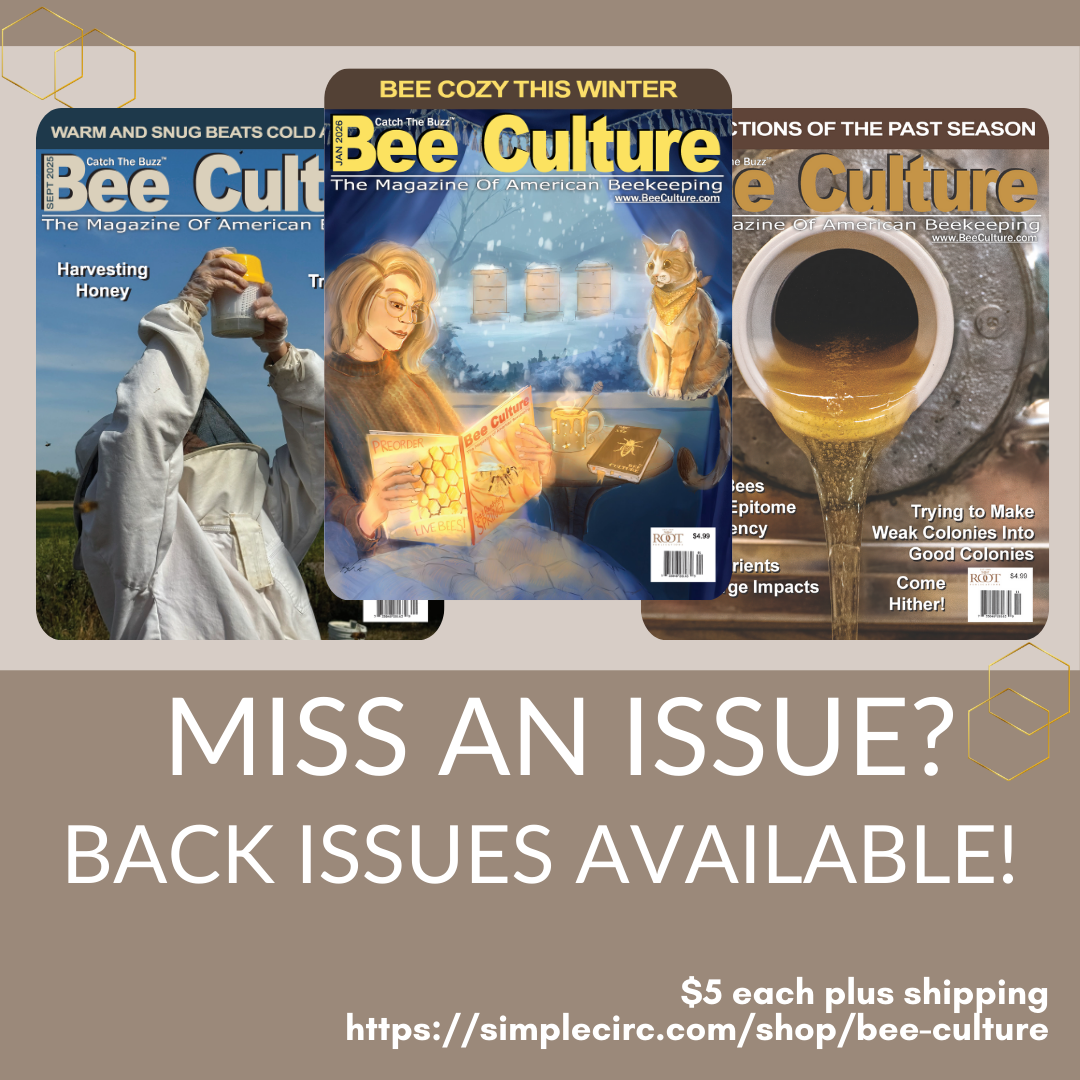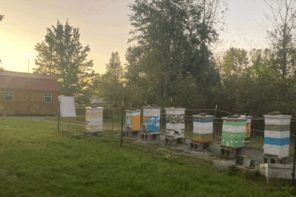This article was reprinted with permission from The Ontario Bee Journal, May/June 2014 and appeared in the Spring 2019 issue of BEEKeeping Your First Three Years
MAY
UNWRAP HIVES
Winter wraps can be removed when the night temperatures are staying above 0°C.
Colonies wintered indoors can be moved outside. If unsure of timing, check with other beekeepers in the immediate area. Some beekeepers unwrap when garden planting may be done without a concern for frost. Keep in mind that the timing depends on the type of Winter wraps and their insulating value. Removing Winter wraps too early will cause the bees to consume honey to maintain the inside temperature of the hive. A strong colony low on honey stores can starve in the Spring, if conditions are not right for foraging (too cold or lack of nectar source). A weaker colony will benefit from staying wrapped if the Spring remains cool.
MONITOR FOR VARROA
An early check for Varroa mites is a good practice. Knowing the hive’s early Spring mite levels will allow planning of any required treatments and to begin treating as soon as possible.
SPRING CLEANING
On a warm day when the bees are actively flying, the hive can be opened. All the frames, boxes, inner covers and bottom boards can be scraped and cleaned. Spring is the best time of year to scrape colonies since the bee populations are smaller and the Winter debris build up needs to be removed. Dead colonies should be inspected to determine the cause of death. If the cause of death is ruled as not contagious, the equipment can be cleaned and made ready for installing nucs or making splits. Equipment not required immediately or unsuitable for re-use should be removed from the beeyard as soon as possible. If there are signs of American foul brood (AFB), incinerate the equipment immediately. Since there are usually a number of empty or almost empty frames, this is a good time of year to replace old and unwanted frames with new comb or foundation.
MAY&JUNE
ASSESSMENTS
It is a good idea to thoroughly assess the colonies for queen status, strength, disease, and mites early in the season. Examine each colony frame by frame.
Check the following:
*Queen status: The presence of eggs in the cells and a solid brood pattern are signs of a healthy productive queen.
*Colony strength: Count how many frames are covered with bees and how many frames are covered with brood. Check honey and pollen stores. The amount of stores will depend on the bee population and foraging conditions. A colony lacking pollen will not be able to maximize brood production.
*Stores: Lack of honey stores can result in starvation, if there are no nectar sources available.
*Presence of diseases: Examine for brood diseases (e.g. chalkbrood, sacbrood, American foulbrood, European foulbrood) and for symptoms among adult bees (e.g. nosema). Examining for diseases should be conducted every time a colony is opened and frames removed, or about once a month. Sometimes, chalkbrood and sacbrood occur in the Spring or with a newly laying queen. However, if sacbrood and chalkbrood are an ongoing problem, the colony should be re-queened.
CHECK COLONIES FOR SPACE
Ensure that the bees are using their space well. Consider how large the bee population is and how much of the brood chamber contains honey and brood. Examine the brood frames. Reverse brood chambers (if running double brood chambers and the bees and brood are completely in the top brood box) or rearrange frames to encourage the queen to lay in empty frames, but keep brood frames together in the middle of the box. Unused brood chambers can be removed from weak colonies and added to strong ones for preservation or in anticipation of making splits.
SPRING MITE AND DISEASE TREATMENTS
After determining the colonies’ health status, treatments should be applied immediately to ensure that the treatment time and withdrawal period (if any) end before honey supers are put on. Check the current Ontario Recommendations distributed by the Provincial Apiarist for proper treatments. Current recommendations can be found on the OBA (www.ontariobee.com) and OMAF apiculture websites. Always read and follow the directions on treatment labels for maximum efficacy and to decrease the development of resistance and the risk of residues.
JUNE
SWARMS
As the season progresses, the bees will build up their populations and stores and potentially become overcrowded. A colony that swarms will lower its population and have a reduced honey crop.
SWARM PREVENTION
Providing additional supers as the bees need space, destroying queen cells if there is a healthy, laying queen and requeening colonies that are inclined to continuously swarm will help reduce the frequency of swarming. You may also want to consider splitting strong colonies to reduce chances of swarming.
SPLITTING COLONIES
Instead of purchasing colonies or nucs, split existing colonies to increase colony numbers. Only strong colonies should be split to ensure survival. Also, splitting a colony will decrease the honey yield of the original colony. Making splits requires planning, equipment preparation, and a mated queen or queen cell to introduce into the queenless split. It is possible to let a queenless split raise its own queen, but the amount of time it takes will weaken the colony overall. In addition, introducing new genetics to the bees is important, especially from bee breeders who actively select breeding stock that are good honey producers with disease and mite resistance.
CATCHING SWARMS
Catching swarms can be an easy way to increase colony numbers. It can be profitable to advertise services for swarm removal. However, remember that t is possible to introduce disease and bad genetics when bringing swarms of unknown origin into an operation. If colonies tend to swarm even though they have adequate space, a beekeeper may be propagating swarming genetics. The process of catching a swarm can be daunting, but the main goal is to get all of the bees, including the queen, into a bucket, box, pail or other form of containment until the bees can be placed into an empty brood chamber. Ensure that the bees can have access to air during transportation.
SUPERING
Giving the bees additional honey supers provides them with more space. As a result, the colony is not overcrowded which reduces the need to swarm and allows more room for honey storage. Add more supers as needed throughout the season when the previous super is half to three-quarters full of capped honey.









